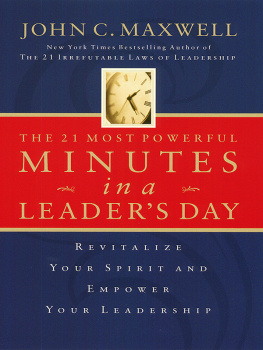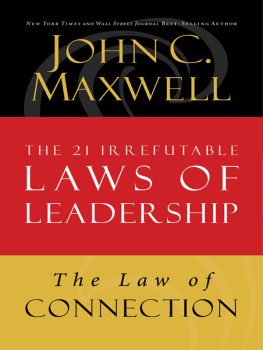John C. Maxwell - The Law of Buy-In: Lesson 14 from the 21 Irrefutable Laws of Leadership
Here you can read online John C. Maxwell - The Law of Buy-In: Lesson 14 from the 21 Irrefutable Laws of Leadership full text of the book (entire story) in english for free. Download pdf and epub, get meaning, cover and reviews about this ebook. year: 2012, publisher: Harpercollins Leadership, genre: Business. Description of the work, (preface) as well as reviews are available. Best literature library LitArk.com created for fans of good reading and offers a wide selection of genres:
Romance novel
Science fiction
Adventure
Detective
Science
History
Home and family
Prose
Art
Politics
Computer
Non-fiction
Religion
Business
Children
Humor
Choose a favorite category and find really read worthwhile books. Enjoy immersion in the world of imagination, feel the emotions of the characters or learn something new for yourself, make an fascinating discovery.
- Book:The Law of Buy-In: Lesson 14 from the 21 Irrefutable Laws of Leadership
- Author:
- Publisher:Harpercollins Leadership
- Genre:
- Year:2012
- Rating:4 / 5
- Favourites:Add to favourites
- Your mark:
- 80
- 1
- 2
- 3
- 4
- 5
The Law of Buy-In: Lesson 14 from the 21 Irrefutable Laws of Leadership: summary, description and annotation
We offer to read an annotation, description, summary or preface (depends on what the author of the book "The Law of Buy-In: Lesson 14 from the 21 Irrefutable Laws of Leadership" wrote himself). If you haven't found the necessary information about the book — write in the comments, we will try to find it.
The first time Judy Estrim started up a company, it took her six months to find the money. The second time it took her about six minutes. What made the difference? The Law of Buy-In.
John C. Maxwell: author's other books
Who wrote The Law of Buy-In: Lesson 14 from the 21 Irrefutable Laws of Leadership? Find out the surname, the name of the author of the book and a list of all author's works by series.
The Law of Buy-In: Lesson 14 from the 21 Irrefutable Laws of Leadership — read online for free the complete book (whole text) full work
Below is the text of the book, divided by pages. System saving the place of the last page read, allows you to conveniently read the book "The Law of Buy-In: Lesson 14 from the 21 Irrefutable Laws of Leadership" online for free, without having to search again every time where you left off. Put a bookmark, and you can go to the page where you finished reading at any time.
Font size:
Interval:
Bookmark:

1998 and 2007 by John C. Maxwell
This ebook is derived from The 21 Irrefutable Laws of Leadership, by John Maxwell, 1998 and 2007 by Maxwell Motivation, Inc., a Georgia corporation.
All rights reserved. No portion of this book may be reproduced, stored in a retrieval system, or transmitted in any form or by any meanselectronic, mechanical, photocopy, recording, scanning, or otherexcept for brief quotations in critical reviews or articles, without the prior written permission of the publisher.
Published in Nashville, Tennessee, by Thomas Nelson. Thomas Nelson is a trademark of Thomas Nelson, Inc.
Thomas Nelson, Inc. titles may be purchased in bulk for educational, business, fund-raising, or sales promotional use. For information, please e-mail SpecialMarkets@ThomasNelson.com.
Published in association with Yates & Yates, LLP, Attorneys and Counselors, Orange, California.
Scripture quotations noted CEV are from THE CONTEMPORARY ENGLISH VERSION.
1991 by the American Bible Society. Used by permission.
Scripture quotations noted The Message are from The Message: The New Testament in Contemporary English. 1993 by Eugene H. Peterson.
ISBN 978-0-7852-7431-5 (HC)
ISBN 978-1-4185-3831-6 (ebook)
ISBN 978-1-4002-7573-1 (ebook of Chapter 14)

This book is dedicated to Charlie Wetzel, my writing partner since 1994. Together weve written more than forty books, and Ive enjoyed our collaboration on every one. As I have labored to add value to others by identifying and teaching leadership principles, Charlie, you have added value to me and my efforts. Your insights and skills as a wordsmith have been enjoyed by millions of readers. As a result, you have made a greater impact on more people than has anyone else in my inner circle. For that I thank you.
CONTENTS


Thank you to the thousands of leaders around the world who learned and sometimes challenged the laws of leadership, thus sharpening my thinking.
Thank you to the team at Thomas Nelson who gave me the chance to revise and improve this book, and especially to Tami Heim for her strategic leadership and to Victor Oliver who was instrumental in the development of the original concept.
Thank you to Linda Eggers, my executive assistant, and her assistant, Sue Caldwell, for their incredible service and willingness to go the extra mile every day.
Thank you to Charlie Wetzel, my writer, and Stephanie, his wife, with-out whose work this book would not have been possible.

People Buy into the Leader, Then the Vision
In the fall of 1997, a few members of my staff and I had the opportunity to travel to India and teach four leadership conferences, something weve done many more times in the last decade. India is an amazing country, full of contradictions. Its a place of beauty, with warm and generous people. It has a strong emerging economy. Yet at the same time millions and millions of its inhabitants live in the worst poverty imaginable. It was there that I was reminded of the Law of Buy-In.
Ill never forget when our plane landed in Delhi. Exiting the airport, I felt as if we had been transported to another planet. There were crowds everywhere. People on bicycles, in cars, on camels and elephants. People on the streets, some sleeping right on the sidewalks. Animals roamed free, no matter where we were. And everything was in motion. As we drove along the main street toward our hotel, I also noticed something else. Banners. Wherever we looked, we could see banners celebrating Indias fifty years of liberty, along with huge pictures of one man: Mahatma Gandhi.
OBSCURE BEGINNINGS
Today, people take for granted that Gandhi was a great leader. But the story of his leadership is a marvelous study in the Law of Buy-In. Mohandas K. Gandhi, called Mahatma (which means great soul), was educated in London. After finishing his education in law, he traveled back to India and then to South Africa. There he worked for twenty years as a barrister and political activist. And in that time he developed as a leader, fighting for the rights of Indians and other minorities who were oppressed and discriminated against by South Africas apartheid government.
By the time he returned to India in 1914, Gandhi was very well-known and highly respected among his countrymen. Over the next several years, as he led protests and strikes around the country, people rallied to him and looked to him more and more for leadership. In 1920a mere six years after returning to Indiahe was elected president of the All India Home Rule League.
The most remarkable thing about Gandhi isnt that he became a leader in India, but that he was able to change the peoples vision for obtaining freedom. Before he began leading them, the people used violence in an effort to achieve their goals. For years riots against the British establishment had been common. But Gandhis vision for change in India was based on nonviolent civil disobedience. He once said, Nonviolence is the greatest force at the disposal of mankind. It is mightier than the mightiest weapon of destruction devised by the ingenuity of man.
A NEW APPROACH
Gandhi challenged the people to meet oppression with peaceful disobedience and noncooperation. Even when the British military massacred more than one thousand people at Amritsar in 1919, Gandhi called the people to standwithout fighting back. Rallying everyone to his way of thinking wasnt easy. But because the people had come to buy into him as their leader, they embraced his vision. And then they followed him faithfully. He asked them not to fight, and eventually, they stopped fighting. When he called for everyone to burn foreign-made clothes and start wearing nothing but homespun material, millions of people started doing it. When he decided that a March to the Sea to protest the Salt Act would be their rallying point for civil disobedience against the British, the nations leaders followed him the two hundred miles to the city of Dandi, where government representatives arrested them.
Their struggle for independence was slow and painful, but Gandhis leadership was strong enough to deliver on the promise of his vision. In 1947, India gained home rule. Because the people had bought into Gandhi, they accepted his vision. And once they had embraced the vision, they were able to carry it out. Thats how the Law of Buy-In works. The leader finds the dream and then the people. The people find the leader and then the dream.
DONT PUT THE CART FIRST
When I teach leadership seminars, I field a lot of questions about vision. Invariably, someone will come up to me during a break, give me a brief description of an evolving vision, and ask me, Do you think my people will buy into my vision?
My response is always the same: First tell me this. Do your people buy into you?
You see, many people who approach the area of vision in leadership have it all backward. They believe that if the cause is good enough, people will automatically buy into it and follow. But thats not how leadership really works. People dont at first follow worthy causes. They follow worthy leaders who promote causes they can believe in. People buy into the leader first, then the leaders vision. Having an understanding of that changes your whole approach to leading people.
Next pageFont size:
Interval:
Bookmark:
Similar books «The Law of Buy-In: Lesson 14 from the 21 Irrefutable Laws of Leadership»
Look at similar books to The Law of Buy-In: Lesson 14 from the 21 Irrefutable Laws of Leadership. We have selected literature similar in name and meaning in the hope of providing readers with more options to find new, interesting, not yet read works.
Discussion, reviews of the book The Law of Buy-In: Lesson 14 from the 21 Irrefutable Laws of Leadership and just readers' own opinions. Leave your comments, write what you think about the work, its meaning or the main characters. Specify what exactly you liked and what you didn't like, and why you think so.


















